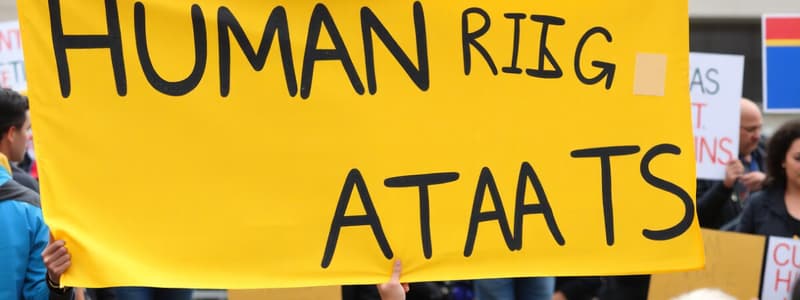Podcast
Questions and Answers
Recognition of the inherent dignity and the equal rights of all persons is fundamental for freedom, justice, and peace in the world.
Recognition of the inherent dignity and the equal rights of all persons is fundamental for freedom, justice, and peace in the world.
True (A)
In Alberta, persons are considered equal only with regard to gender and age.
In Alberta, persons are considered equal only with regard to gender and age.
False (B)
Multiculturalism is acknowledged as a fundamental principle in Alberta's society.
Multiculturalism is acknowledged as a fundamental principle in Alberta's society.
True (A)
The purpose of the BC Code includes fostering barriers to participation in social life.
The purpose of the BC Code includes fostering barriers to participation in social life.
The Alberta Act and the BC Code contain specific legislative requirements.
The Alberta Act and the BC Code contain specific legislative requirements.
Race is specifically defined in both BC and Alberta legislation.
Race is specifically defined in both BC and Alberta legislation.
Promoting a climate of understanding and mutual respect is a goal of the BC Code.
Promoting a climate of understanding and mutual respect is a goal of the BC Code.
Identifying patterns of inequality is not a concern of the BC Code.
Identifying patterns of inequality is not a concern of the BC Code.
Discrimination based on religious beliefs is protected even if the beliefs are not essential elements of a particular religion.
Discrimination based on religious beliefs is protected even if the beliefs are not essential elements of a particular religion.
The term 'colour' in this context refers to the color of a person's hair.
The term 'colour' in this context refers to the color of a person's hair.
The richness of life in Alberta is believed to be enhanced by sharing cultural diversity.
The richness of life in Alberta is believed to be enhanced by sharing cultural diversity.
Discrimination on the basis of gender extends only to male and female individuals.
Discrimination on the basis of gender extends only to male and female individuals.
Alberta legislation does not recognize native spirituality as a form of religious belief.
Alberta legislation does not recognize native spirituality as a form of religious belief.
Gender identity is linked to a person's external appearance of gender.
Gender identity is linked to a person's external appearance of gender.
Discrimination on the ground of colour includes only physical harassment.
Discrimination on the ground of colour includes only physical harassment.
Employers must take positive measures to accommodate employees' religious practices, such as allowing breaks for prayer.
Employers must take positive measures to accommodate employees' religious practices, such as allowing breaks for prayer.
Documenting hiring decisions can help employers defend against claims of discrimination.
Documenting hiring decisions can help employers defend against claims of discrimination.
All employment decisions are considered discriminatory if any reason involves a prohibited ground.
All employment decisions are considered discriminatory if any reason involves a prohibited ground.
Employers do not need to regularly update job descriptions.
Employers do not need to regularly update job descriptions.
In 2022 – 23, 78 percent of complaints in Alberta were related to employment.
In 2022 – 23, 78 percent of complaints in Alberta were related to employment.
Sexual orientation was included as a specific ground in the Alberta Act prior to 2009.
Sexual orientation was included as a specific ground in the Alberta Act prior to 2009.
Only essential duties should be evaluated when determining a person's ability to perform a job.
Only essential duties should be evaluated when determining a person's ability to perform a job.
The BC Code includes source of income as a ground of employment discrimination.
The BC Code includes source of income as a ground of employment discrimination.
It is unnecessary for employers to review job requirements during the hiring process.
It is unnecessary for employers to review job requirements during the hiring process.
Subtle discrimination in the workplace can violate human rights.
Subtle discrimination in the workplace can violate human rights.
Political belief is recognized as a ground of discrimination in the BC Code.
Political belief is recognized as a ground of discrimination in the BC Code.
Temporary work and volunteer work are considered types of employment under Alberta's broad interpretation.
Temporary work and volunteer work are considered types of employment under Alberta's broad interpretation.
The interpretation of BFORs is based solely on personal opinions of the employer.
The interpretation of BFORs is based solely on personal opinions of the employer.
Morrison v AdvoCare and Turner v Canada Border Services Agency are examples of cases related to workplace discrimination.
Morrison v AdvoCare and Turner v Canada Border Services Agency are examples of cases related to workplace discrimination.
The BC Human Rights Tribunal reported that 78 percent of complaints were related to employment in 2022 – 23.
The BC Human Rights Tribunal reported that 78 percent of complaints were related to employment in 2022 – 23.
The grounds of discrimination related to employment in BC and Alberta have several similarities.
The grounds of discrimination related to employment in BC and Alberta have several similarities.
The Supreme Court decision concerning Vriend v Alberta resulted in the addition of political belief to Alberta's legislation.
The Supreme Court decision concerning Vriend v Alberta resulted in the addition of political belief to Alberta's legislation.
Conciliation is the only method available before a case management meeting is held.
Conciliation is the only method available before a case management meeting is held.
A human rights hearing is conducted in the same manner as a traditional court hearing.
A human rights hearing is conducted in the same manner as a traditional court hearing.
The panel that hears human rights cases is prohibited from allowing legal representation for the parties.
The panel that hears human rights cases is prohibited from allowing legal representation for the parties.
A panel’s decisions in human rights cases do not carry the same weight as court decisions.
A panel’s decisions in human rights cases do not carry the same weight as court decisions.
A reconsideration of a decision by a human rights panel can be requested anytime regardless of circumstances.
A reconsideration of a decision by a human rights panel can be requested anytime regardless of circumstances.
Complaints related to matters covered by a collective agreement are typically addressed by human rights panels.
Complaints related to matters covered by a collective agreement are typically addressed by human rights panels.
Parties can file complaints under both human rights and collective agreement jurisdiction.
Parties can file complaints under both human rights and collective agreement jurisdiction.
In Alberta, if a complaint is filed in multiple forums, only the employer can apply for a marshalling order.
In Alberta, if a complaint is filed in multiple forums, only the employer can apply for a marshalling order.
Requiring a driver’s licence for a non-driving job may infringe the Alberta Act or BC Code.
Requiring a driver’s licence for a non-driving job may infringe the Alberta Act or BC Code.
It is acceptable to discriminate against someone who speaks English with a non-Canadian accent.
It is acceptable to discriminate against someone who speaks English with a non-Canadian accent.
An employer does not have to accommodate an individual if it causes undue hardship.
An employer does not have to accommodate an individual if it causes undue hardship.
The Meiorin case involved a firefighter who lost her job due to a new physical fitness test.
The Meiorin case involved a firefighter who lost her job due to a new physical fitness test.
Undue hardship is defined as creating a minor inconvenience for the employer.
Undue hardship is defined as creating a minor inconvenience for the employer.
Accommodation must always be provided to individuals regardless of the situation.
Accommodation must always be provided to individuals regardless of the situation.
The Supreme Court of Canada established the undue hardship standard in 1999.
The Supreme Court of Canada established the undue hardship standard in 1999.
The Meiorin case has no relevance to the recruitment and hiring processes.
The Meiorin case has no relevance to the recruitment and hiring processes.
Flashcards
Alberta Preamble's Core Principle
Alberta Preamble's Core Principle
The Alberta preamble emphasizes that everyone has inherent dignity and equal, inalienable rights. This is considered a fundamental principle in Alberta, forming the basis of freedom, justice, and peace.
Equality in Alberta
Equality in Alberta
The Alberta preamble highlights that all individuals in Alberta are equal in dignity, rights, and responsibilities, regardless of their background.
Multiculturalism in Alberta
Multiculturalism in Alberta
The Alberta preamble acknowledges the diverse racial and cultural makeup of Alberta society and recognizes its value.
BC Code's Purpose: Inclusion
BC Code's Purpose: Inclusion
Signup and view all the flashcards
BC Code's Focus: Respect and Equality
BC Code's Focus: Respect and Equality
Signup and view all the flashcards
BC Code's Goal: Preventing Discrimination
BC Code's Goal: Preventing Discrimination
Signup and view all the flashcards
Beyond Prevention: Eliminating Inequality
Beyond Prevention: Eliminating Inequality
Signup and view all the flashcards
Redress for Discrimination
Redress for Discrimination
Signup and view all the flashcards
Prohibited Grounds of Discrimination in Employment
Prohibited Grounds of Discrimination in Employment
Signup and view all the flashcards
Employment
Employment
Signup and view all the flashcards
Alberta Human Rights Act Section 7
Alberta Human Rights Act Section 7
Signup and view all the flashcards
BC Human Rights Code Section 13
BC Human Rights Code Section 13
Signup and view all the flashcards
Vriend v. Alberta
Vriend v. Alberta
Signup and view all the flashcards
Addition of Sexual Orientation in Alberta
Addition of Sexual Orientation in Alberta
Signup and view all the flashcards
Gender Identity
Gender Identity
Signup and view all the flashcards
Gender Expression
Gender Expression
Signup and view all the flashcards
What is an essential job requirement?
What is an essential job requirement?
Signup and view all the flashcards
How can discrimination impact hiring?
How can discrimination impact hiring?
Signup and view all the flashcards
Why is a current job description important?
Why is a current job description important?
Signup and view all the flashcards
Why should employers document hiring decisions?
Why should employers document hiring decisions?
Signup and view all the flashcards
What is 'subtle scent of discrimination'?
What is 'subtle scent of discrimination'?
Signup and view all the flashcards
What is 'prohibited ground of discrimination'?
What is 'prohibited ground of discrimination'?
Signup and view all the flashcards
What should employers consider when analyzing a job?
What should employers consider when analyzing a job?
Signup and view all the flashcards
Why is careful documentation important?
Why is careful documentation important?
Signup and view all the flashcards
Informal Settlement Discussions
Informal Settlement Discussions
Signup and view all the flashcards
Mediation
Mediation
Signup and view all the flashcards
Case Management Meeting
Case Management Meeting
Signup and view all the flashcards
Human Rights Hearing
Human Rights Hearing
Signup and view all the flashcards
Human Rights Panel
Human Rights Panel
Signup and view all the flashcards
Reconsideration Request
Reconsideration Request
Signup and view all the flashcards
Collective Agreement Grievance
Collective Agreement Grievance
Signup and view all the flashcards
Marshalling Order
Marshalling Order
Signup and view all the flashcards
Unnecessary Job Requirements
Unnecessary Job Requirements
Signup and view all the flashcards
Language and Discrimination
Language and Discrimination
Signup and view all the flashcards
Duty to Accommodate
Duty to Accommodate
Signup and view all the flashcards
Undue Hardship
Undue Hardship
Signup and view all the flashcards
Meiorin Case Significance
Meiorin Case Significance
Signup and view all the flashcards
Bona Fide Occupational Qualification
Bona Fide Occupational Qualification
Signup and view all the flashcards
Undue Hardship in Accommodation
Undue Hardship in Accommodation
Signup and view all the flashcards
Reasonable Accommodation
Reasonable Accommodation
Signup and view all the flashcards
What does 'colour' mean in human rights?
What does 'colour' mean in human rights?
Signup and view all the flashcards
Who is protected under 'gender, gender identity, and gender expression'?
Who is protected under 'gender, gender identity, and gender expression'?
Signup and view all the flashcards
What does the law say about religious beliefs?
What does the law say about religious beliefs?
Signup and view all the flashcards
How is 'race' defined in human rights?
How is 'race' defined in human rights?
Signup and view all the flashcards
What is 'gender expression'?
What is 'gender expression'?
Signup and view all the flashcards
What is 'gender identity'?
What is 'gender identity'?
Signup and view all the flashcards
What does 'transgender' mean?
What does 'transgender' mean?
Signup and view all the flashcards
How does Alberta define 'transgender'?
How does Alberta define 'transgender'?
Signup and view all the flashcards
Study Notes
Learning Outcomes
- Explain discrimination under the British Columbia Human Rights Code and the Alberta Human Rights Act.
- Identify prohibited grounds and areas of discrimination in these statutes.
- Understand the difference between equal pay for equal value and employment equity.
- Outline remedies available to complainants.
- State the requirements of human rights legislation during hiring (job ads, applications, interviews).
- Understand issues with pre-employment testing (medical, drug, and alcohol).
- Understand implications of human rights legislation during employment (duty to accommodate disability, religion, sex, and family status).
Understanding Discrimination and Human Rights Complaints
- Discrimination was once legal in Canada under common law, allowing stores, landlords, and employers to discriminate based on factors like race, gender, or marital status.
- Human rights legislation now prohibits discrimination in employment, services, and accommodation, which are key considerations through the entire employment relationship.
- Provincial human rights statutes are used for individual and corporate actions.
- Legislation in Alberta and British Columbia outlines the rights of employees and prohibits discrimination and harassment within workplaces.
What Constitutes Discrimination
- Discrimination is not explicitly defined in Alberta or BC Codes, but is addressed in court cases which usually involves a three-part test.
- The three-part test for establishing a prima facie case of discrimination: (1) the complainant has a protected characteristic, (2) they experienced an adverse effect related to employment, and (3) the protected characteristic was a factor in the adverse effect.
Key Features of Human Rights Legislation
- Both private and public sectors are covered by human rights legislation.
- No exceptions exist, beyond specific defined grounds.
- Different provinces have similar but not identical prohibited grounds for discrimination in employment (example listed)
- Discrimination doesn't need to be intentional, only have a discriminatory effect on individuals or groups.
- Legislation is remedial, primarily to rectify issues and to compensate victims.
Prohibited Grounds of Discrimination in Employment
- Specific prohibited grounds for discrimination in employment (listed)
- Includes race, religious beliefs, colour, gender, gender identity, gender expression, physical disability, mental disability, age, ancestry, place of origin, marital status, family status, and sexual orientation.
- Some specific grounds may differ between Alberta and British Columbia.
Additional Grounds of Discrimination - Equal Pay for Equal Work
- Employees performing similar work should be compensated equally.
- Employers cannot reduce an employee's salary to comply with this section of the legislation.
Additional Grounds of Discrimination - Pay Equity
- Pay equity, or equal pay for work of equal value, is also defined as evaluating the value of different jobs that may appear dissimilar but are equal.
- Both Alberta and BC legislation have similar language for equal pay for similar work.
Employee Rights
- Employers have a duty to accommodate employees' needs, unless this causes undue hardship.
- If accommodation is impossible without causing undue hardship, the employer is not required to fulfill it.
Additional Grounds of Discrimination
- Protected grounds of discrimination (listed).
- Specific examples and how some grounds are broader or narrower in meaning than in the same context in other regions.
- Legislation is meant to guard against discrimination across various categories.
Harassment
- Harassment is conduct of a prohibited sex or gender in the workplace or other specified protected grounds.
- Examples of behaviour classified as harassment (listed).
- Employer liability is considered, whereby an organization can be held liable for the actions of their employees.
Employer Responsibilities
- Employers are responsible for taking reasonable measures to investigate any complaints of harassment.
- Procedures, policies, and protocols of handling complaints, resolving disputes, and enforcing rights should be clearly defined within organizational systems.
Discrimination, Hiring and Recruitment
- Job descriptions should accurately reflect the job's essential requirements.
- Testing for job candidates is only allowed under specific conditions, and must be done in a way that does not discriminate.
- Employers are prohibited from making inquiries about an applicant’s protected status.
- Interviews and applicant forms should not discriminate on the basis of protected status and must be handled appropriately and objectively to avoid complaints.
Pre-Employment Medical/Fitness Examinations, Drug and Alcohol Testing
- Medical tests are only valid after a conditional job offer to ensure validity and alignment with job needs.
- Employees can be required to undergo drug or alcohol testing in specific contexts, but not for all jobs.
- The testing must be handled in a manner that respects an employee's rights, privacy, and dignity.
Employer Terminations
- Employer terminations must be justifiable, reasonable, and avoid discrimination on the basis of a protected ground.
Employer Terminations - Accommodating Employees
- The duty to accommodate, as well as the need to justify specific standards, are two essential aspects for justifying terminations.
- Reasonable accommodation is a necessary part of employment.
Key Legal Concepts
- Bona fide occupational requirement (BFOR).
Studying That Suits You
Use AI to generate personalized quizzes and flashcards to suit your learning preferences.




